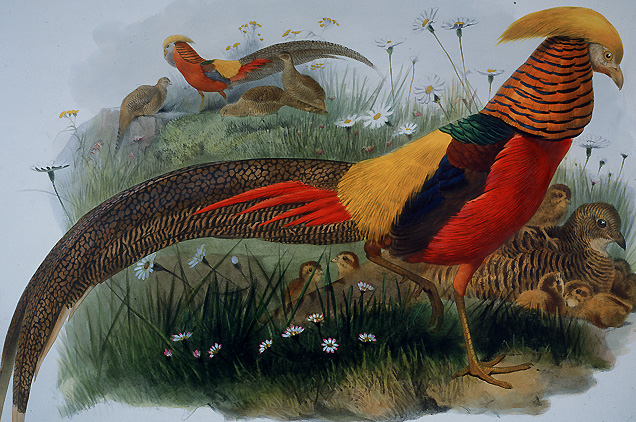 Golden Pheasant
Golden Pheasant Golden Pheasant
Golden Pheasant
Found throughout the mountains
of Central China from south-east Tsinghai eastward through southern
Kansu to southern Shensi north to the Tsinling Range, southward
through Szechwan, Kweichow, western Hupeh and western Hunan to
northern Kwangsi (Johnsgard 1986).
Golden pheasants are often
considered the most beautiful of all game birds, Golden Pheasants
are one of the Ruffed Pheasants. The other is the Lady Amherst
Pheasant (Chrysolophus amherstiae). Golden Pheasants are adorned
with a disintegrated crest which flows backwards and with a large
ruff of long, broad feathers that starts at the nape and can be
spread like a fan around the head and neck. The dominant body
colors are yellow and red, with the ruff being orange barred with
black.
Historically, Golden Pheasants were released for sport, but since
they preferred to run through undergrowth rather than fly, their
popularity in shoots rapidly diminished while the importance of
their feathers grew in fly tying.
For the trout fly tier,
"the big, arched centre tail feather of this bird is the
only one of use to the small fly dresser. The feather is beautifully
marbled with brown and black, and single strands containing these
colours are wound to form the bodies of the Spring Black Gnat,
as an alternative to, or improvement in, strands of turkey tail.
The breast feather of the hen is used to front May Flies, and
bits of the smaller tipped feathers are sometimes used as tails
to fancy patterns" (V.C. 1950). In streamers such as the
Millers River Special, the red side feather from this pheasant
is used for the shoulder, and streamers such as the Maynard Marvel
and the Golden Marvel contain numerous crest feathers from the
Golden Pheasant for the wing (Stewart and Leeman 1982).
Nearly every salmlon fly uses feathers from the Golden Pheasant.
The golden crest feathers are used for tails as well as toppings,
and the orange and black ruff feathers, known as tippets, are
mostly used for wings (Lady Blanche, King Alfred, Orange Parson,
Sir Herbert, Stevenson), veilings (Tippetiwitchet), and as hackle
for Tippet Grubs. Tail fiber sections are used as components in
wings (Blue Doctor, Black Doctor, Black Dose, Cound, Dunkeld,
Popham, Nansen) and the red rump feathers are used in the tail
of the Welsh fly Tomey Tivey and for the wing in Stephen.
If you want to know more about these birds and others related to our fly tying heritage, we suggest you order Rare and Unusual Fly Tying Materials: A Natural History.